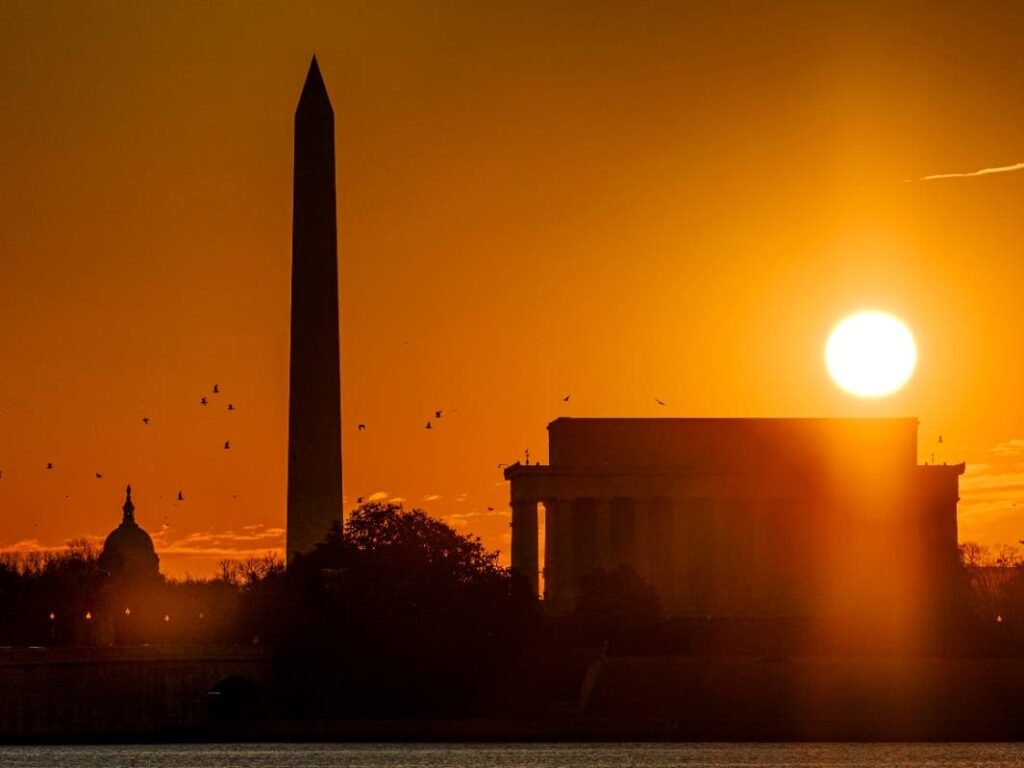
The sun rises above the Lincoln Memorial in Washington. If daylight saving time becomes permanent, as President Donald Trump has proposed, the sun wouldn’t rise until after 8:30 a.m. in Washington at the height of winter. (AP Photo/J. David Ake, File),
Congress is considering and President Donald Trump is backing bipartisan legislation that would mean Americans would no longer have to change their clocks twice a year to accommodate daylight saving time.
,
Trump said Friday on his Truth Social platform that both the House and Senate “should push hard for more Daylight at the end of a day.”
“Very popular and, most importantly, no more changing of the clocks, a big inconvenience and, for our government, A VERY COSTLY EVENT!!!”
,
The Republican president’s endorsement for more daylight at the end of the day could push the debate schedule forward. His post came a day after a Senate panel heard testimony examining whether to set one time all year instead of shifting.
Nearly 70 bills in at least 31 states filed in 2025 are fairly evenly divided between those favoring permanent standard time and those favoring year-round daylight saving time, according to the National Conference of State Legislatures.
,
Of note, North Dakota, where the sun wouldn’t rise until after 9 a.m. for much of the winter under daylight saving time, passed a bill in the House to permanently adopt standard time.
The first serious effort to end the twice-a-year clock-changing ritual was the Sunshine Protection Act, championed by former Florida senator and now Secretary of State Marco Rubio. Four years after he first introduced it, the bill to make daylight saving time permanent sailed through the Senate with rare unanimous support. The effort stalled in the House after some representatives argued in favor of year-round standard time.
,
Trump appeared to have agreed with them in a December post on his social media platform. He wrote at the time, “The Republican Party will use its best efforts to eliminate Daylight Saving Time, which has a small but strong constituency, but shouldn’t! Daylight Saving Time is inconvenient, and very costly to our Nation.”
The Sunshine Protection Act was reintroduced in the House and Senate by Florida Republicans Rep. Vern Buchanan and Sen. Rick Scott.
,
Daylight saving time pushes sunshine an hour later in the evening. It was enacted as a wartime measure in 1918 to conserve energy by aligning daylight hours with the times when most people are active. DST was widely unpopular, and Congress abolished it after the war.
DST was established again in 1942 during World War II. The year-round “wartime” lasted until Sept. 30, 1945. States and cities, especially those east of the Mississippi River, began adopting DST in the years after, and it wasn’t until the1966 that dates were standardized for the beginning and end of daylight saving time. The law allowed for some exemptions, which are in effect today in Arizona and Hawaii.
Polls over the years, including scientific YouGov, Monmouth University and Associated Press-NORC poll surveys, have shown a majority of Americans are weary of fiddling with their clocks twice a year. Where they disagree is whether daylight saving or standard time should be permanent.
An informal survey of Patch readers last fall mirrored the findings of those and other polls on whether to keep or ditch daylight saving time.
“Whatever is chosen, just keep it the same. Stop changing the clocks!” a reader from Virginia told Patch. “I literally have to take off the Monday and Tuesday after the spring forward, or my work suffers for a week. It takes me that long to adjust.”
,
Those advocating for year-round daylight saving time cite mainly economic reasons. They argue that when school and work are over for the day, DST gives people an extra hour of daylight to frequent local businesses, restaurants and other community amenities. Others say permanent daylight saving time could reduce crime.
Medical experts say daylight saving time disrupts the human body’s natural circadian rhythms. Increases in the risk of heart attacks and strokes, mood disturbances and traffic crashes due to decreased alertness are also associated with the time switch. Parents say it throws off their kids’ bedtimes. In 2020, the American Academy of Sleep Medicine said it believed the U.S. should “eliminate seasonal time changes in favor of a national, fixed, year-round time.”
Legislation has been filed this year in a handful of states — Utah, Kentucky, North ‘Carolina and Texas — seeking the same exemptions Hawaii and Arizona received. Hawaii received an exemption because, owing to its tropical latitude, there’s little variation in the hours of daylight in winter and summer. In hot and sunny Arizona, the additional hour of sunshine at the end of the day defeated the energy savings goals of the time switch.
If nothing happens at the federal level, DST will end on Sunday, Nov. 2 — again assuming nothing happens in Washington to stop it.







